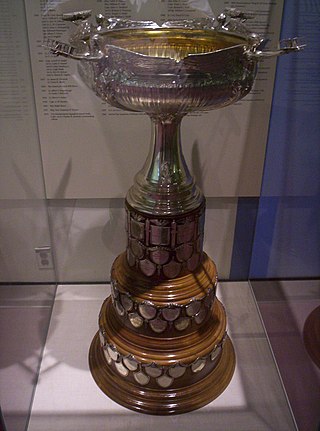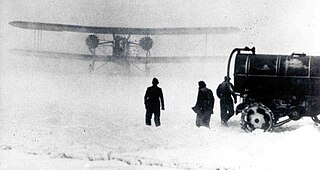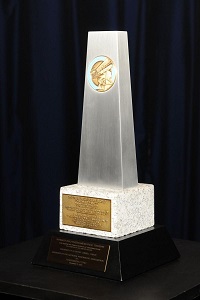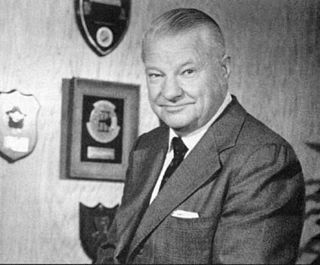
The Federal Aviation Administration (FAA) is a U.S. federal government agency within the U.S. Department of Transportation which regulates civil aviation in the United States and surrounding international waters. Its powers include air traffic control, certification of personnel and aircraft, setting standards for airports, and protection of U.S. assets during the launch or re-entry of commercial space vehicles, powers over neighboring international waters were delegated to the FAA by authority of the International Civil Aviation Organization.

Commercial aviation is the part of civil aviation that involves operating aircraft for remuneration or hire, as opposed to private aviation.

The National Advisory Committee for Aeronautics (NACA) was a United States federal agency that was founded on March 3, 1915, to undertake, promote, and institutionalize aeronautical research. On October 1, 1958, the agency was dissolved and its assets and personnel were transferred to the newly created National Aeronautics and Space Administration (NASA). NACA is an initialism, i.e., pronounced as individual letters, rather than as a whole word.

The Robert J. Collier Trophy is an annual aviation award administered by the U.S. National Aeronautic Association (NAA), presented to those who have made "the greatest achievement in aeronautics or astronautics in America, with respect to improving the performance, efficiency, and safety of air or space vehicles, the value of which has been thoroughly demonstrated by actual use during the preceding year."
Contempt of Congress is the misdemeanor act of obstructing the work of the United States Congress or one of its committees. Historically, the bribery of a U.S. senator or U.S. representative was considered contempt of Congress. In modern times, contempt of Congress has generally applied to the refusal to comply with a subpoena issued by a congressional committee or subcommittee—usually seeking to compel either testimony or the production of requested documents.

The Mackay Trophy is awarded yearly by the United States Air Force for the "most meritorious flight of the year" by an Air Force person, persons, or organization. The trophy is housed in the Smithsonian Institution's National Air and Space Museum. The award is administered by the U.S. National Aeronautic Association.
The Air Commerce Act of 1926 created an Aeronautic Branch of the United States Department of Commerce. Its functions included testing and licensing of pilots, certification of aircraft and investigation of accidents.

The Civil Aeronautics Board (CAB) was an agency of the federal government of the United States, formed in 1938 and abolished in 1985, that regulated aviation services and conducted air accident investigations. The agency was headquartered in Washington, D.C.

The Willard InterContinental Washington, commonly known as the Willard Hotel, is a historic luxury Beaux-Arts hotel located at 1401 Pennsylvania Avenue NW in Downtown Washington, D.C. It is currently a member of Historic Hotels of America, the official program of the National Trust for Historic Preservation. Among its facilities are numerous luxurious guest rooms, several restaurants, the famed Round Robin Bar, the Peacock Alley series of luxury shops, and voluminous function rooms. Owned jointly by Carr Companies and InterContinental Hotels & Resorts, it is two blocks east of the White House, and two blocks west of the Metro Center station of the Washington Metro.
The National Aeronautic Association of the United States (NAA) is a non-profit 501(c)(3) organization and a founding member of the Fédération Aéronautique Internationale (FAI). Founded in 1905, it is the oldest national aviation club in the United States and one of the oldest in the world, it serves as the “Aeroclub of the United States” and, by its Mission Statement it is "…dedicated to the advancement of the art, sport and science of aviation in the United States.” The NAA is headquartered at the Ronald Reagan Washington National Airport, in Washington, D.C.

The Air Mail scandal, also known as the Air Mail fiasco, is the name that the American press gave to the political scandal resulting from a 1934 congressional investigation of the awarding of contracts to certain airlines to carry airmail and the subsequent disastrous use of the U.S. Army Air Corps to fly the mail after the contracts were revoked.

Paul B. MacCready Jr. was an American aeronautical engineer. He was the founder of AeroVironment and the designer of the human-powered aircraft that won the first Kremer prize. He devoted his life to developing more efficient transportation vehicles that could "do more with less".

Almer Stillwell "Mike" Monroney was an American politician who served as a United States senator from Oklahoma from 1951 to 1969, and previously as the United States representative for Oklahoma's 5th congressional district from 1939 until 1951. A member of the Democratic Party, Monroney was the last Democrat to hold Oklahoma’s Class 3 Senate seat.

Fred Ernest Weick (1899–1993) was an airmail pilot, research engineer, and aircraft designer. Working at the NACA, he won the 1929 Collier Trophy for his design of the NACA cowling for radial air-cooled engines. Weick's aircraft designs include the Ercoupe, Piper PA-25 Pawnee, and Cherokee.

The Wright Brothers Memorial Trophy was established by the National Aeronautic Association (NAA) in 1948 after a trust fund was created in 1936 by Godfrey Lowell Cabot of Boston, a former president of the NAA. It is awarded to a living American for "significant public service of enduring value to aviation in the United States." The presentation of the award is made annually at the Aero Club of Washington, as close as possible to December 17 each year, the day on which, in 1903, the Wright brothers made the first flight in an airplane. The inaugural recipient of the trophy was William F. Durand, "a pioneer in aeronautics, naval propulsion and engineering research methods". Until 2010, winners of the award received a trophy depicting the Wright brothers' Wright Flyer aircraft. From 2010 onwards, a redesigned trophy featuring a silver obelisk and bronze inscription has been awarded.

Clarence Leonard "Kelly" Johnson was an American aeronautical and systems engineer. He is recognized for his contributions to a series of important aircraft designs, most notably the Lockheed U-2 and SR-71 Blackbird. Besides the first production aircraft to exceed Mach 3, he also produced the first fighter capable of Mach 2, the United States' first operational jet fighter, as well as the first fighter to exceed 400 mph, and many other contributions to various aircraft.
Jurney v. MacCracken, 294 U.S. 125 (1935), was a case in which the Supreme Court of the United States held that Congress has an implicit power to find one in contempt of Congress. During a Senate investigation of airlines and of the U.S. Postmaster General, the attorney William P. MacCracken, Jr. allowed his clients to destroy subpoenaed documents. After a one-week trial on the Senate floor, MacCracken, a lawyer and former Assistant Secretary of Commerce for Aeronautics, was found guilty and sentenced to 10 days imprisonment. MacCracken filed a petition of habeas corpus with the federal courts to overturn his arrest, but, after litigation, the U.S. Supreme Court ruled that Congress had acted constitutionally, and denied the petition.

The United States capital, Washington, D.C., has been the site of several events in the nation's history of aviation, beginning from the time of the American Civil War, often for the purpose of promoting the adoption of new aeronautical technologies by the government. It has also been home to several governmental and civilian aircraft manufacturers and aviation organizations, and several aerospace contractors.
Henry W. Hofstetter was an American optometrist and the author of two books and 500 research papers. He is a past president of the American Optometric Association and a member of the National Optometry Hall of Fame.
















